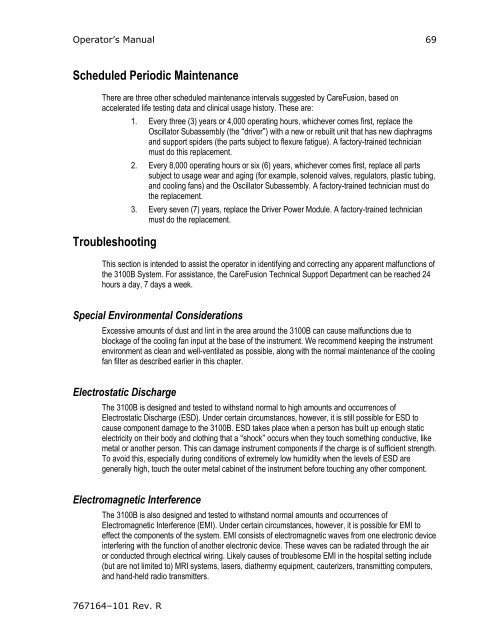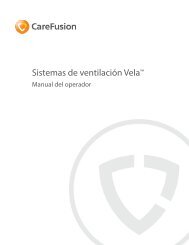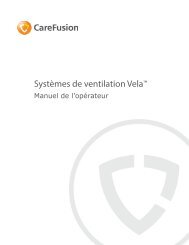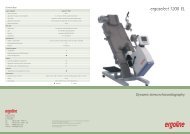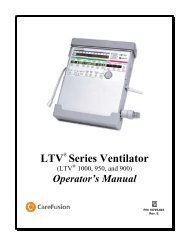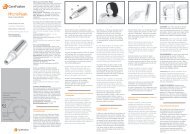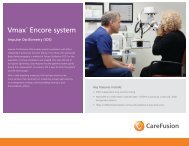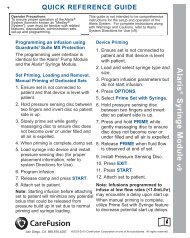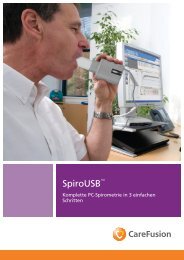3100B HFOV Operator Manual - CareFusion
3100B HFOV Operator Manual - CareFusion
3100B HFOV Operator Manual - CareFusion
You also want an ePaper? Increase the reach of your titles
YUMPU automatically turns print PDFs into web optimized ePapers that Google loves.
<strong>Operator</strong>’s <strong>Manual</strong> 69<br />
Scheduled Periodic Maintenance<br />
There are three other scheduled maintenance intervals suggested by <strong>CareFusion</strong>, based on<br />
accelerated life testing data and clinical usage history. These are:<br />
Troubleshooting<br />
1. Every three (3) years or 4,000 operating hours, whichever comes first, replace the<br />
Oscillator Subassembly (the “driver”) with a new or rebuilt unit that has new diaphragms<br />
and support spiders (the parts subject to flexure fatigue). A factory-trained technician<br />
must do this replacement.<br />
2. Every 8,000 operating hours or six (6) years, whichever comes first, replace all parts<br />
subject to usage wear and aging (for example, solenoid valves, regulators, plastic tubing,<br />
and cooling fans) and the Oscillator Subassembly. A factory-trained technician must do<br />
the replacement.<br />
3. Every seven (7) years, replace the Driver Power Module. A factory-trained technician<br />
must do the replacement.<br />
This section is intended to assist the operator in identifying and correcting any apparent malfunctions of<br />
the <strong>3100B</strong> System. For assistance, the <strong>CareFusion</strong> Technical Support Department can be reached 24<br />
hours a day, 7 days a week.<br />
Special Environmental Considerations<br />
Excessive amounts of dust and lint in the area around the <strong>3100B</strong> can cause malfunctions due to<br />
blockage of the cooling fan input at the base of the instrument. We recommend keeping the instrument<br />
environment as clean and well-ventilated as possible, along with the normal maintenance of the cooling<br />
fan filter as described earlier in this chapter.<br />
Electrostatic Discharge<br />
The <strong>3100B</strong> is designed and tested to withstand normal to high amounts and occurrences of<br />
Electrostatic Discharge (ESD). Under certain circumstances, however, it is still possible for ESD to<br />
cause component damage to the <strong>3100B</strong>. ESD takes place when a person has built up enough static<br />
electricity on their body and clothing that a “shock” occurs when they touch something conductive, like<br />
metal or another person. This can damage instrument components if the charge is of sufficient strength.<br />
To avoid this, especially during conditions of extremely low humidity when the levels of ESD are<br />
generally high, touch the outer metal cabinet of the instrument before touching any other component.<br />
Electromagnetic Interference<br />
The <strong>3100B</strong> is also designed and tested to withstand normal amounts and occurrences of<br />
Electromagnetic Interference (EMI). Under certain circumstances, however, it is possible for EMI to<br />
effect the components of the system. EMI consists of electromagnetic waves from one electronic device<br />
interfering with the function of another electronic device. These waves can be radiated through the air<br />
or conducted through electrical wiring. Likely causes of troublesome EMI in the hospital setting include<br />
(but are not limited to) MRI systems, lasers, diathermy equipment, cauterizers, transmitting computers,<br />
and hand-held radio transmitters.<br />
767164–101 Rev. R


